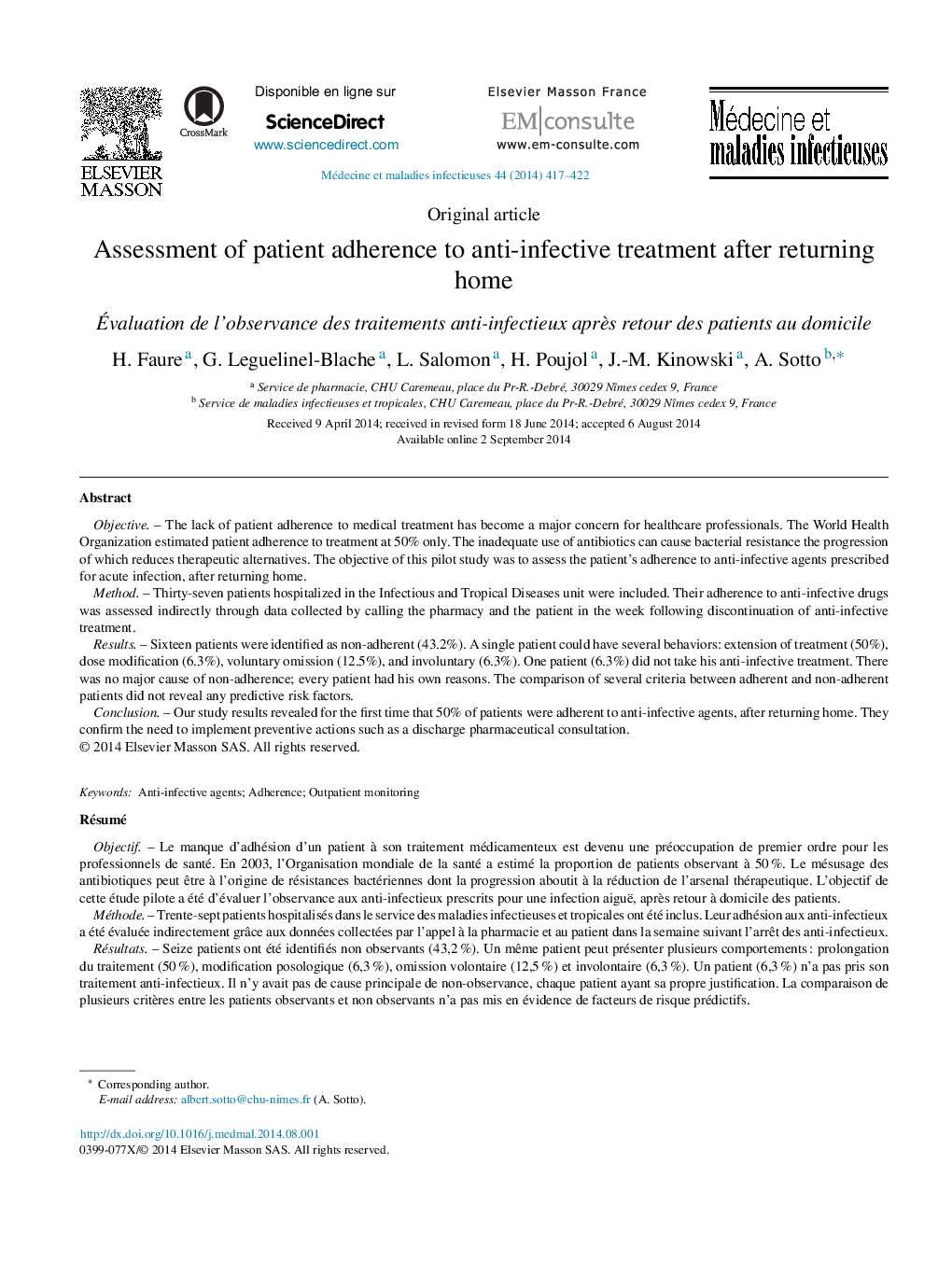| Article ID | Journal | Published Year | Pages | File Type |
|---|---|---|---|---|
| 3412624 | Médecine et Maladies Infectieuses | 2014 | 6 Pages |
ObjectiveThe lack of patient adherence to medical treatment has become a major concern for healthcare professionals. The World Health Organization estimated patient adherence to treatment at 50% only. The inadequate use of antibiotics can cause bacterial resistance the progression of which reduces therapeutic alternatives. The objective of this pilot study was to assess the patient's adherence to anti-infective agents prescribed for acute infection, after returning home.MethodThirty-seven patients hospitalized in the Infectious and Tropical Diseases unit were included. Their adherence to anti-infective drugs was assessed indirectly through data collected by calling the pharmacy and the patient in the week following discontinuation of anti-infective treatment.ResultsSixteen patients were identified as non-adherent (43.2%). A single patient could have several behaviors: extension of treatment (50%), dose modification (6.3%), voluntary omission (12.5%), and involuntary (6.3%). One patient (6.3%) did not take his anti-infective treatment. There was no major cause of non-adherence; every patient had his own reasons. The comparison of several criteria between adherent and non-adherent patients did not reveal any predictive risk factors.ConclusionOur study results revealed for the first time that 50% of patients were adherent to anti-infective agents, after returning home. They confirm the need to implement preventive actions such as a discharge pharmaceutical consultation.
RésuméObjectifLe manque d’adhésion d’un patient à son traitement médicamenteux est devenu une préoccupation de premier ordre pour les professionnels de santé. En 2003, l’Organisation mondiale de la santé a estimé la proportion de patients observant à 50 %. Le mésusage des antibiotiques peut être à l’origine de résistances bactériennes dont la progression aboutit à la réduction de l’arsenal thérapeutique. L’objectif de cette étude pilote a été d’évaluer l’observance aux anti-infectieux prescrits pour une infection aiguë, après retour à domicile des patients.MéthodeTrente-sept patients hospitalisés dans le service des maladies infectieuses et tropicales ont été inclus. Leur adhésion aux anti-infectieux a été évaluée indirectement grâce aux données collectées par l’appel à la pharmacie et au patient dans la semaine suivant l’arrêt des anti-infectieux.RésultatsSeize patients ont été identifiés non observants (43,2 %). Un même patient peut présenter plusieurs comportements : prolongation du traitement (50 %), modification posologique (6,3 %), omission volontaire (12,5 %) et involontaire (6,3 %). Un patient (6,3 %) n’a pas pris son traitement anti-infectieux. Il n’y avait pas de cause principale de non-observance, chaque patient ayant sa propre justification. La comparaison de plusieurs critères entre les patients observants et non observants n’a pas mis en évidence de facteurs de risque prédictifs.ConclusionCette étude montre pour la première fois, qu’environ un patient sur deux est observant aux anti-infectieux, lors du retour au domicile. Elle confirme la nécessité de mettre en œuvre des actions de prévention comme une consultation pharmaceutique de sortie.
